Pinch Valve - How They Work
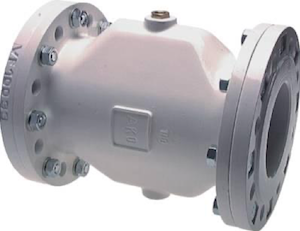
Figure 1: A pneumatic pinch valve with flanged end connections.
A pinch valve is a 2/2-way valve designed to shut off or control the flow of corrosive, abrasive, or granular media. It utilizes pressurized air to open or close the valve. In the open position, the valve has no restrictions and allows a wide range of media to pass through the bore. The flexible internal rubber sleeve in the valve keeps the media isolated from the rest of the valve, preventing contamination or damage to the valve’s other components. Figure 1 is an example of a pneumatic pinch valve.
Pinch valves are suited for use with slurries and granular products like sand, cement, gravel, textile fiber, carbon, powder, pellets, chipping, and glass fragments. These valves are cost-effective, reliable, and easy to use, making them desirable in various industrial applications.
Table of contents
- How does a pinch valve work?
- Pinch valve P&ID symbol
- Advantages
- Disadvantages
- Selection criteria
- Applications
- FAQs
Check out our pinch valve selection!
How does a pinch valve work?
The pinch valve diagram in Figure 2 illustrates a pinch valve’s important components. Three major components are the housing (Figure 2 labeled D), the sleeve (Figure 2 labeled E), and the end connections (Figure 2 labeled G). The rubber sleeve is fitted into the housing from inlet to outlet and is the only component that contacts the media. The end connections are bolted, screwed, or threaded at each end to provide support and connection to the valve.
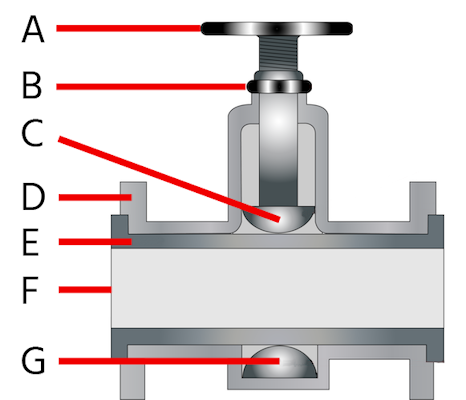
Figure 2: Pinch valve diagram: handwheel (A), stem (B), upper pinch bar (C), housing (D), sleeve (E), lower pinch valve (F), and end connections (G).
Pinch valve operation can be either mechanical or automatic. A mechanical pinch valve is a multi-turn valve, meaning the handwheel (Figure 2 labeled A) turns more than 360° during the opening and closing of the valve. The valve’s normal position is open (Figure 3 labeled A). While the handwheel turns, the valve stem (Figure 2 labeled B) lowers. A pinch bar (Figure 2 labeled C) presses against the mid-section of the pinch valve’s sleeve until the sleeve is pinched tightly (Figure 3 labeled B) and flow stops. Another mechanical pinch valve design has a lowering pinch bar and a rising pinch bar from the bottom (Figure 2 labeled F).
Automatic pinch valves operate using compressed air, hydraulic fluid, or a solenoid. While the medium operating the pinch valve differs slightly between the three automatic pinch valve types, the result is the same. A pneumatic pinch valve uses compressed air to pinch tight the center of the sleeve. A hydraulic pinch valve uses hydraulic fluid to do the same. Finally, a solenoid pinch valve uses an electric current to control the movement of a plunger that pinches down the sleeve.
In conventional valves, such as ball valves and gate valves, particles can get trapped around the ball or disc and clog the valve. However, the pinch valve’s rubber sleeve closes around and traps particles, ensuring that these particles will flow through the system once the pinch valve opens.
When force is no longer applied to the rubber sleeve, the sleeve’s elastic rebounding property, along with the force of the upstream flow, fully opens the valve. The fully opened valve provides free flow passage to the media, preventing the valve from clogging or blockage. When abrasive media strikes the rubber pinch valve sleeve, the sleeve absorbs the impact and deflects its energy back to the media. This resilient property ensures slower wear and longer service life than valves using metal surfaces.
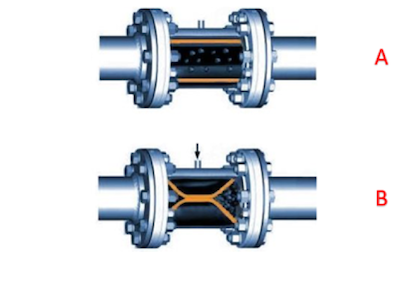
Figure 3: Operating principle of a pinch valve: open position (A) and closed position (B).
Pinch valve P&ID symbol
The two symbols in figure 4 are alternative versions of the pinch valve symbol. Piping and instrumentation diagrams (P&IDs) use these symbols. Read our valve symbols article to learn more about how to interpret symbols.
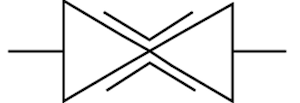

Figure 4: Pinch valve symbol (left) and alternative pinch valve symbol (right).
Advantages
Pinch valves have a unique design, providing them with the following advantages:
- Great to use with abrasive and corrosive media
- Straight flow path and no clogging by the media
- Minimum turbulence and friction
- Keeps media free from contamination
- Easy replacement of the rubber sleeves and a low maintenance cost
- Excellent sealing properties
- Quick opening and closing time
- Low energy consumption
Disadvantages
The few disadvantages of pinch valves are:
- Due to the elastomeric property of the pinch valve sleeve, the valve is unsuitable for high-temperature applications.
- The high-pressure differential can cause the rubber sleeve to collapse or deform, causing the valve not to open fully.
- The valve is unsuitable for vacuum applications as suction inside the valve may lead the sleeve to collapse.
Selection criteria
Consider the following criteria while selecting a pinch valve for an application:
-
Material:
- The valve body material should be lightweight for easy handling. The material does not need to be compatible with the media since they do not come in contact.
- The rubber sleeve should be given careful consideration because it is the only component that comes in contact with the media.
- The pinch valve sleeve material may include natural rubber, NBR (nitrile), EPDM (ethylene propylene diene monomer), silicon, food quality rubber, etc.
- The material should have good abrasion resistance to avoid damage by the media.
-
Pressure: To prevent a failure to open/close, take the following pressure differentials, as seen in figure 5, into account:
- Opening: The operating pressure (Figure 5 labeled A) needs to be greater than the control pressure (Figure 5 labeled B). If the pressure difference is not big enough, the operating pressure will not be able to open the sleeve. Control pressure is typically 0 bar when opening.
- Closing: The control pressure needs to be greater than the operating pressure. If the pressure difference is not big enough, the control pressure will not be able to close the valve.
Max Control Pressure = Operating Pressure + Max Pressure Differential
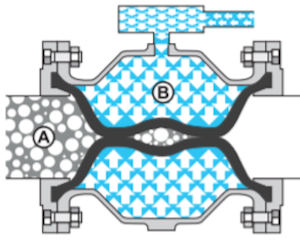
Figure 5: Pressure system in a pinch valve: operating pressure (A) and control pressure (B).
- Temperature: Ensure that the valve materials can withstand the application’s minimum and maximum operating temperatures.
- Certification: Some applications may require certification for safety and no media contamination (e.g., food grade, drinking water, etc.).
Applications
Industrial applications increasingly use pinch valves due to their advantages. Some of the industries using pinch valves include:
- Food and beverage industries: Sanitary pinch valves have rubber sleeves made of nitrile, natural rubber, and EPDM, all of which are FDA-approved for contacting food. Also, a pinch valve cycles rapidly, which significantly increases packaging efficiency.
- Pharmaceutical industry: Similar to the food industry, the pharmaceutical industry demands cleanliness, making sanitary pinch valves a good choice.
- Chemical industry: The chemical industry has a broad range of applications. Pinch valves can accommodate many of these applications because of the variety of materials available for pinch valve sleeve production.
- Cement industry: Natural rubber pinch valve sleeves are durable enough to withstand cement’s abrasion.
- Bulk and solid handling industry: Pinch valves offer the abrasion resistance necessary to handle bulks and solids. The valves’ full-bore opening prevents solids from clogging the valve.
- Ceramic industry: Pinch valves with reinforced rubber sleeves can handle the extreme abrasiveness of a ceramic flow.
- Plastics industry: Pinch valves are suitable for moving plastic pellets and nibs, which may clog up other types of valves.
- Wastewater industry: Pinch valves operate as pressure relief and shut-off valves in the wastewater industry.
FAQs
What is a pinch valve?
A pinch valve is ideal for shutting off or controlling the flow of abrasive, granular, or corrosive media.
How does a pinch valve work?
The valve’s actuator pushes down at the middle of the sleeve to close the valve. This pinching traps any media still in the middle and stops flow entirely.
What is a pinch valve used for?
Pinch valves are suitable for many different applications. Most noteworthy, pinch valves are exceptional at controlling and stopping the flows of abrasive and solid media.





